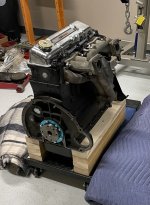KVH
Obi Wan
Offline
This is a good article. > Engine Installation TR-4 Spring 2009 <.
I'm still wondering about something, however. How do you torque the front fan extension dog bolt in the crank to 110 ft lbs after the engine is already rebuilt and put back into the vehicle? It seems easier by using a block of wood before oil pan installation, and then to lower the engine into the vehicle with the fan extension already on and torqued. My steering is already moved and out of the way, so I'm inclined to put the fan extension on first, but if I do it later won't I be putting an awful stress on my transmission to reach that torque spec with the car in gear being the only "stop."
Also, even if there's room to pre-install the front fan extension and dog bolt, is there some concern that during the process of engine installation and lowering onto the engine mounts that the extension assembly might get hit and damage the crank? Is that a reason behind the suggested process of installing the extension later?
I seem to recall another process whereby a bar is bolted to the fan assembly to stop it from turning as the dog bolt is tightened, though at 100 ft lbs for the dog bolt it seems something else might give, like the fan extension bolts.
Thanks all.
I'm still wondering about something, however. How do you torque the front fan extension dog bolt in the crank to 110 ft lbs after the engine is already rebuilt and put back into the vehicle? It seems easier by using a block of wood before oil pan installation, and then to lower the engine into the vehicle with the fan extension already on and torqued. My steering is already moved and out of the way, so I'm inclined to put the fan extension on first, but if I do it later won't I be putting an awful stress on my transmission to reach that torque spec with the car in gear being the only "stop."
Also, even if there's room to pre-install the front fan extension and dog bolt, is there some concern that during the process of engine installation and lowering onto the engine mounts that the extension assembly might get hit and damage the crank? Is that a reason behind the suggested process of installing the extension later?
I seem to recall another process whereby a bar is bolted to the fan assembly to stop it from turning as the dog bolt is tightened, though at 100 ft lbs for the dog bolt it seems something else might give, like the fan extension bolts.
Thanks all.

 Hi Guest!
Hi Guest!

 smilie in place of the real @
smilie in place of the real @
 Pretty Please - add it to our Events forum(s) and add to the calendar! >>
Pretty Please - add it to our Events forum(s) and add to the calendar! >> 

